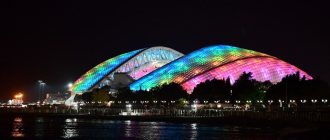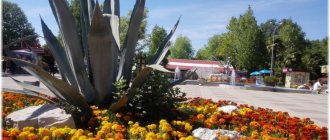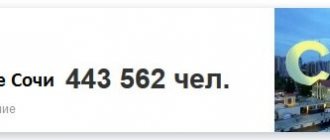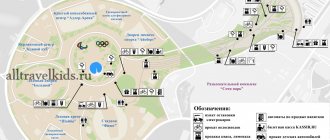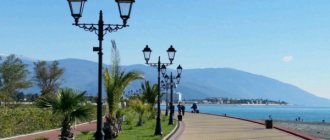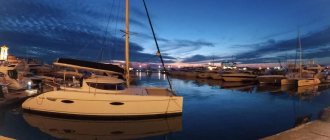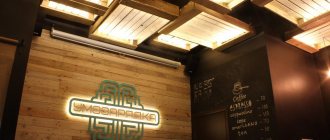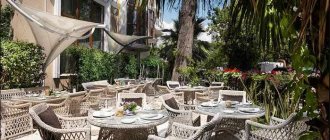The main Olympic village of Sochi (coastal village “Usadba”) is located in the Imeretinskaya lowland of the Adler region. During the Olympic and Paralympic Games of the 2014 Olympics, the majority of international delegates and athletes participating in the Olympics (in a number of disciplines) were accommodated in a specially built coastal complex.
Near the Sochi Olympic Village there are:
- complex of sports facilities Olympic Park;
- amusement park Sochi Park;
- race track Sochi Autodrom.
© Igor Butyrskii
Story
According to Wikipedia, construction of the Olympic Village in Adler began in 2007. At that important time for Russia, large-scale construction began on the territory where a couple of state farms and small settlements had previously been located.
Before the Olympic and Paralympic Games were held in the Imereti Valley, buildings were erected for the future residence of athletes, transport infrastructure facilities providing convenient movement to the town and access to it, and most importantly, grandiose sports facilities.
In less than seven years, in an unknown place, a huge stadium, two ice palaces, arenas, the Medal Plaza square, where competition winners were awarded, and much more appeared.
A village near the Black Sea coast.
The Olympic Village, which forms a single complex with the Olympic Park, today is a residential area of comfortable premium class apartments.
Thanks to the unique layout, the windows of the houses offer impressive views of the mountain peaks, the Black Sea and the most famous sports facilities in the country.
It is convenient to live and relax here, because the buildings were designed taking into account the requirements of the International Olympic Committee.
Many buildings are now equipped as hotels. If you wish, stay in one of the clean, comfortable rooms, and the prices of local hotels are quite affordable.
Vacationers have at their disposal the beautiful and spacious Imeretinskaya embankment, many restaurants, souvenir shops, and tourist attractions.
It even has its own Adler power plant. The thermal power plant, which was built to provide uninterrupted energy supply to the Olympic village in Sochi and all sports facilities, made it possible to completely solve energy supply problems.
Sometimes guests are surprised by the name of the attraction, because the ultra-modern quarter does not look like a village.
They say that it was named the village by analogy with the Summer Olympics held in Paris in 1924. Then simple wooden houses were built for the participants of the Olympic Games, and the area really resembled a rural settlement.
Construction.
Names of Olympic sports venues "Sochi-2014". Integrated concept
During the Games, the names of objects will be used everywhere: from signs on city streets to specialized electronic information systems for the “Olympic family.” Guests of the Games will see these names on electronic displays on buses, trains and maps in mobile phones. These names should be bright, catchy, brief, and carry a strong emotional component. At the same time, they should be harmonious for both Russian speakers and foreigners, and not cause negative associations.
Together with experts in the field of communications with experience in preparing the Games, participants in the Sochi-2014 project, more than 200 names of objects were developed. After this, focus groups were held, in which more than 100 people took part.
The best ideas were integrated into this concept. It is based on the use of Russian words that can become or have already become the international calling card of Russia, as well as geographical names of the region where the Games will be held. This concept provides additional benefits for promoting the national and innovative nature of the Games, the city of Sochi, and the Krasnodar Territory.
Coastal cluster
Bolshoy Ice Dome
On the one hand, the name of the Ice Palace emphasizes the features of the sports facility. The Bolshoi will become one of the most capacious Olympic venues, designed to host competitions in the most popular sports. At the same time, the word “Bolshoi”, which has become understandable and recognizable among representatives of many countries and peoples, evokes a strong association with Russia - the Bolshoi Theater, the traditions of the Russian school of ballet, figure skating, hockey and other achievements of the largest country in the world.
Olympic Stadium "Fisht" Olympic Stadium
Mount Fisht rises 2,857 meters above sea level and is one of the most popular and famous peaks in the Russian expanses. Translated from the Adyghe language, the name of the mountain means “White Head”, “White Frost” or “Grey-Headed”. The mountain got its name from the glacier on its top. The sparkling snow cap also served as the prototype for the original architectural concept of the central Olympic stadium. By the way, the transparent roof of this sports facility will allow spectators to view the mountain from the foot to the peak.
Speed skating Olympic Oval Skating Center
The skating center received its name due to its elegant shape, reminiscent of an oval.
Ice Arena "Shayba" "Shayba" Arena
The puck is a sports equipment, without which it is impossible to imagine playing hockey. The name can accurately reflect the purpose of the object. In addition, for Russians the cry “Puck!” is a universal and recognizable way to support a hockey team at international championships. Thus, this name emphasizes the nature of the “Russian” Winter Games.
Iceberg Winter Sports Palace Iceberg Skating Palace
Curling "Ice Cub" Curling Center
The names evoke associations with the architectural form of the object and the shape of the stadium. They are international and sound the same in Russian, English and German.
Mountain cluster
Ski "Rosa Khutor" Alpine Center
Rosa Khutor is a unique ski resort located in the Krasnaya Polyana area. The name comes from the geographical name of the Rosa Khutor , covering approximately 1,820 hectares of the slopes of the Aibga mountain ridge, rising from the Mzymta River. By now, the ski resort is already a major ski center in the North Caucasus region. Complex for cross-country skiing and biathlon competitions "Laura" "Laura" Cross-country Sky & Biathlon Center
Laura is a mountain turbulent river with a large number of waterfalls. It originates on the southern slopes of the Assara ridge within the Caucasus Nature Reserve. The history of the name of the river is based on a legend that says that a young girl named Laura chose death over life with an unloved person - an old prince. Having escaped from the old man, Laura threw herself off a cliff into the river that later gave her name. Murat, Laura’s lover, could not bear the pain of parting and rushed after his bride. The bodies of the lovers were never found, and local residents say that the Gods themselves were shocked by what happened and accepted the girl into their Heavenly abode on the top of the sacred Mount Elbrus.
Ski jumping complex "Russian roller coaster" "RusSki Gorki" Jumping Center
The name “Russian roller coaster” gives associations with the shape of the object (springboards). In English, the attraction that we know as “Roller Coaster” is called “Russian Coaster”. The combination of the abbreviation “Rus” and the word “Ski” is played on. Nearby is the Gorki Gorod , where the mountain media village will be located.
Sliding Center "Sanki"
Mass sledding, sledding and ice sledding has been a traditional Russian pastime since the time of Peter I. Sleighing has always been an integral part of the winter leisure time of any child in Russia. For Russians, they are a source of positive emotions and pleasant memories of childhood. The name will highlight the flavor of the Games and accurately reflect the functional purpose of the sports facility. The word “sledge” is euphonious in most foreign languages.
Snowboard Park & Freestyle Center - “X-treme” Snowboard Park & Freestyle Center
"Architecture of Sochi"
[tp_search_shortcodes id=1 origin="" destination=""]
5 / 5 ( 13 votes)
What to see
Olympic Village is a cozy neighborhood consisting of cute cottages with red tiled roofs.
Attractions are located nearby and can be easily reached on foot.
And the residential area itself is perfect for leisurely walks, contemplating the sea coast and enjoying the fresh breeze.
In the morning, you can leisurely drink coffee on the balcony and go for a short jog along the embankment, where world champions recently trained.
In the evening, it’s nice to taste local cuisine and admire the magical southern sunset.
You won’t have to look long for attractions in the vicinity of the Olympic Village in Sochi.
Here are just a few of them:
- Fisht Stadium , where the opening and closing ceremonies of the Olympics took place.
- Fountain "Olympic Flame Bowl". In the evenings, there are light and sound shows with multi-colored jets of water thrown to a height of up to 60 meters.
- Sochi Park with a huge variety of attractions. Entrance cost – 1,250 rubles. for adults and 1,000 for children, there are also benefits.
- Sochi Autodrom , which served as a track during Formula 1 racing.
If you still can’t see these unique objects in person, look on the Internet. Thanks to the web cameras installed in the Olympic village, live broadcasts are broadcast from here from morning to evening.
View of the sights in the vicinity of the Olympic Village.
"Shayba" ice arena
“Shaiba” is the second most important stadium, located next to the “Big” Ice Palace. It was originally built as a children's hockey center. It has an unusual, daring design that is great for a teenage, rebellious spirit.
There were big plans for ice rental. After the Olympic Games, they wanted to transport her to Vladikavkaz, Krasnodar or Nizhny Novgorod. But, as often happens, it turned out that the foundation would not survive the move, and the structure remained in place.
During the 2014 Games, hockey matches were held at Shaiba, and now it houses the All-Russian Children's Sports and Fitness Center. The capacity is 7,000 seats, and 2.5 billion rubles were spent on construction - not much by Olympic standards.
Olympic Village at different times of the year
While many resort towns in Russia are suitable only for summer holidays, the Sochi Olympic Village is good at any time of the year.
Each season here has its own charm:
- Summer is a great opportunity to combine relaxation on the beach and sightseeing. But hotel vacancies are difficult to find, so book your room in advance.
- In early autumn, the weather in Sochi is ideally mild, and the sea water is still warm. In addition, many tourists go home, and hotels offer good discounts.
- Winter is the time for ski lovers. Since apartments in Krasnaya Polyana and Rosa Khutor are not cheap in the winter season, rent a coastal hotel and go skiing on the slopes during the day.
- In spring , the Olympic Village, like the Adler district, is buried in flowers. In March, you will see how the magnolia tree opens, and to enjoy subtropical nature in all its splendor, visit the Southern Cultures arboretum.
So, no matter when you come, you won’t be bored. But it is better to draw up a walking program in advance so as not to miss the most interesting corners.
Olympic Village in summer.
Iceberg Ice Palace
The Iceberg Ice Palace is one of the most grandiose buildings in the Olympic village with a height of 34 m. The scale is impressive even on a global scale, the palace is designed for 12 thousand spectators. It resembles a real block of ice due to its asymmetrical shape and stained glass of different shades of blue along the entire perimeter of the cladding. The interior layout is no less thoughtful. Three ice arenas for hockey, two for speed skating, three for figure skating, gyms with modern equipment.
We tested its capabilities in advance; in 2012, speed skating and figure skating competitions were held here. During the Olympics, the palace hosted Russia's triumphant figure skating and short track competitions.
The design of the facility is demountable; it was planned to move it after the Olympics to another region or rebuild it into a cycle track. But the ice palace remained in the same place. Now it is actively used due to its versatility: “Iceberg” can host competitions not only in winter, but also in summer sports. The Black Sea Cup hockey tournament, dance competitions and even boxing and wrestling championships are organized here.
In addition, the site is popular for music concerts and ice shows. Evgeni Plushenko and Ilya Overbukh gave performances here. In summer, mass skating and hockey are organized for amateurs. Anyone can come, rent skates and feel like a participant in the Olympics.
Prices in the Olympic Village
Prices for housing, food, gifts and souvenirs, as well as other tourist delights, are acceptable in the Olympic Village.
As a guide, look at the cost of accommodation in local hotels in June:
- “Lazur Beach Hotel” 4* ⇒ – from 5,500 rub. for two (with breakfast).
- Diana Palace 4* ⇒ – from 3,500 rub. for two (with breakfast).
- GC "Bogatyr" 4* ⇒ , especially popular among families with children - from 12,000 rubles. (with breakfast and dinner).
If it seems that the prices are too high, use the services of the private sector, where there are always free places.
Well-groomed territory of one of the courtyards of the village.
Restaurants and shops
When visiting the Olympic Village in Sochi, indulge in shopping and gastronomic pleasures.
Here are a few places where you can dine deliciously and not too expensive:
- Cafe "Fed Mishka" , located between the Olympic Park and Sochi Park. The family-type establishment has a special children's menu; at the request of clients, parties are organized for young guests.
- “Shashlyk” is a cozy cafe in the Olympic Park with the freshest meat dishes cooked on the grill and affordable prices. The opening hours of the establishment are from 11-00 to 23-00.
- Restaurant "Baikal" is a famous place in the city with pleasant, unobtrusive music and a beautiful summer veranda. The price level here is higher, but the dishes will be prepared by a famous chef from Italy. On the menu you will find exquisite delicacies of Italian, European and Japanese cuisine.
Shopping in the Olympic Village includes clothing and souvenir shops (including those with sports symbols), as well as grocery stores.
There are also small markets where you can buy fresh fruits, vegetables and gifts for the home.
Restaurant "Baikal".
Where is
The Olympic Village, which is an elite resort area of the Imereti Lowland, is located along Parusnaya and Golubaya streets, west of the Olympic Park.
Geographically it belongs to the Adler region. The distance from the center of Sochi is 40 km.
Attraction address: Krasnodar region, Sochi, Adler microdistrict.
Olympic symbol.
Location on the map
Many tourists travel around the outskirts of Sochi in their own car or rent a car at Adler airport.
In this case, the coordinates for the navigator will be useful:
- 43.24472399 latitude;
- 39.57360791 longitude.
To get to your destination faster, plot your route on the map in advance.
Olympic village layout
Object diagram.
How to get there
Now it’s worth finding out how to get to the Olympic town in Adler. This is easy to do both by public transport and by car.
Here are the possible options.
By bus
The following vehicles operate on the Sochi Center-Olympic Village route:
- Bus number 57k , which depart from Sochi railway station and arrive at the Olympic Park. The traffic interval is 20 minutes, the ticket costs 30 rubles.
- Bus and minibuses No. 124с. Departure from the Sochi bus station, the final stop is the Olympic Park. The journey takes an hour, the ticket price is 70 rubles.
If you are coming from Adler Airport , take any transport that says “To Adler”, get off at the “New Century” stop and change to bus No. 57 or take a taxi, the cost of which is from 500 rubles.
By train
If you want to get to the Olympic Village quickly, inexpensively and comfortably, take the Lastochka commuter train running from Sochi railway station.
The stop you need is called “Olympic Park”. The train takes 40-45 minutes to Adler.
The ticket price starts from 155 rubles, you will find the schedule on the park website: https://Olympic-park.rf/94-lastochka-sochi-raspisanie-ceny-marshruty.html.
Railway Station "Olympic Park"
In the photo below, the Olympic Park is only a kilometer away, but there is no entrance for spectators. You need to take the Lastochka and then walk another 1.5 kilometers to the stadiums.
This is what the Sochi Olympic Park railway station looks like.
Train schedule at the Olympic Park station. The train schedule to the park from Sochi will be below in the “How to get to the park” section.
View of the stands for Formula 1.
The descent to the turnstiles of the Olympic Park is landscaped with a fountain.
The Olympic rings are the main symbol of any Olympics.
